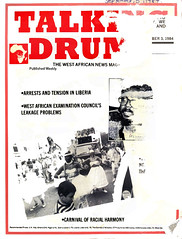Music And Arts Scene
African Records Review
By Kwabena Asamoah
NAKA RAMIRO ET L'ORCHESTRE DE LA GUINEE BISSAU: 'Je Viens d'Ailleurs' (RA DYA MUSIC DYA 81055). 'Ou Moundou Balas' 'Africa Querida' 'Je Viens d'Alleurs'/'Fanta Mané' 'Onca Bidado'.
As a pioneer of his native goumbe (pronounced gumbey) in Paris and flying his national flag there, Naka Ramiro hit the music scene last year with 'Naka' and this follow-up promises to confirm his place on the African chart in Paris.Noted for his dynamic use of lyrics 'Tantie Alaba' 'Akpêtêchi Seller'/ based on themes related to Africa as a 'Odo' 'Who Is Free'. whole and the pride with which he makes use of African costume, Naka Ramiro may go places with this album under his own label after a brief spell with Ambience Safari. Except 'Ou Moundou Balas' which is done in Salsa, he skilfully restricts himself to his native Guinea Bissau goumbé pop form throughout the album.
Not only is he dynamic in his use of words but he also has the linguistic knack of singing in various languages French, Portuguese, Creole, Mandinga and Mandjacque.
Apart from 'Africa Querida' and 'Onca Bidado' which are smootchers, the rest of the tracks are firmly rooted in the uptempo of goumbé. Naka Ramiro's rich voice comes out in 'Ou Moundou Balas' where the high- pitched female vocal chorus back up with near success. The horns riffs and twists combine beautifully with the conga and percussion. You will certainly feel the full effects of Naka Ramiro's beautiful voice in 'Onca Bidado'.
With the throbbing bass guitar at the background and the female vocal line sounding almost like horns, Naka Ramiro introduces the title track - Je Viens d'Ailleurs - which is the best on the album. The horns arrangements fit the mood and the tempo of the music that is well-rehearsed.
In 'Fanta Mané' Naka Ramiro ventures a call-and-answer with the not-too-perfect female vocal line. Sung in Creole, the tune is attractive and the tenor sax solo soothing and tidy. Cheer up with the album.
A.B. CRENTSIL OF SUPER SWEET TALKS INTERNATIONAL: Tantie Alaba' (OIR 007).
A.B. Crentsil who together with Eric Agyemang and Thomas Frempong have occasionally joined forces with Teddy Osei and Mac Tontoh and others to play as Hi-Life Stars is noted for his uptempo hi-life. With the famous 'Adjoa' hit album Crentsil and the Super Sweet Talks reached a wider audience across the entire West African sub-region and beyond.It is hardly surprising that this new album was released in Abidjan, Ivory Coast, where you could not hope to have a successful party last year without playing Adjoa. Probably wanting to keep to that tempo, Crentsil puts together an uptempo in 'Tantie Alaba' (Aunty Araba) which initially relies on heavy percussion, handclaps and horns riffs. The guitar patterns itself into the sax riffs that echo into the music created by the other instruments. When Crentsil as usual invites everybody to the dance floor the warmth of the music climbs into ecstasy up to the end of the track. The conga is at work and Arthur Kennedy (who has only recently been medically advised to give up his trumpet) shoots some interesting solos into the air.
'Akpêtêchi Seller' (akpeteshie is a brand of cheap gin in Ghana) is slightly less poignant just as 'Odo' (love) but the lyrics are interesting: the drunkard prefers to pay his rent first before his akpêtêchi bill in order to ensure that he has somewhere to sleep after his booze. Though a mid-tempo, 'Who Is Free' weaves itself more into a well-arranged music that will please most people. The horns come in well and the conga hits hard. But Crentsil in his characteristically blasphemous mood may once again offend the religious susceptibil- ities of some listeners as he wonders why daily prayers to God do not necessarily yield immediate results. The track however, stands out as the best on the album.
Kwame Nkrumah's contribution to Africa
The story is still being told - whether Dr Kwame Nkrumah was the greatest pan-Africanist of this era. Books have been written about him and numerous articles and analysis done on his ideas.On September 1, 1984, the Commonwealth Institute holds a symposium on Nkrumah's position in African history and his concept of African history.
Photographs of Kenya
A photographic exhibition which tells the story of Kenya's struggle for independence and the country's develop- ment in the post colonial era using fascinating archive and contemporary material.Meshack Asare
This Ghanaian artist who won an award last year with his brilliant illustration of a children's book 'The brassman's secret' will be exhibiting in the Bhownagree Gallery from Septem- ber 12-October 7. His work is striking in its exuberant use of bold colours and interpretation of traditional Ghanain influences.ADVERTISE IN TALKING DRUMS
